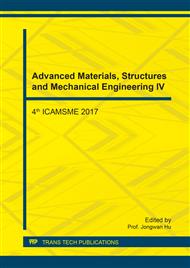[1]
H. T. Chou, Y. C. Chen, C. Y. Lee, H. Y. Chang, N. H. Tai, Switchable transparency of dual-controlled smart glass prepared with hydrogel-containing graphene oxide for energy efficiency, Sol. Energ. Mater. Sol. Cell. 166 (2017) 45-51.
DOI: 10.1016/j.solmat.2017.01.025
Google Scholar
[2]
G. Tahtali, Z. Has, C. Doyranli, C. Varlikli, S. Koyuncu, Solution processable neutral state colourless electrochromic devices: Effect of the layer thickness on the electrochromic performance, J. Mater. Chem. C. 4 (2016) 10090-10094.
DOI: 10.1039/c6tc04112d
Google Scholar
[3]
T. Choi, J. S. Kim, J. H. Kim, Transparent nitrogen doped TiO2/WO3 composite films for self-cleaning glass applications with improved photodegradation activity, Adv. Powd. Tech. 27 (2016) 347-353.
DOI: 10.1016/j.apt.2016.01.005
Google Scholar
[4]
W. Luo, X. K. Fu, L. H. Ma, The research on the high quality TiO2, MoO3-doped WO3 electrochromic film, Chinese Chem. Lett. 18 (2007) 883-886.
DOI: 10.1016/j.cclet.2007.05.003
Google Scholar
[5]
C. L. Wu, C. K. Lin, S. C. Wang, J. L. Huang, Electrochromic properties of nanostructured tungsten oxide films prepared by surfactant-assisted sol-gel process, Surf. Coat. Tech. 231 (2013) 403-407.
DOI: 10.1016/j.surfcoat.2012.01.061
Google Scholar
[6]
S. Xie, K. Ouyang, Degradation of refractory organic compounds by photocatalytic fuel cell with solar responsive WO3/FTO photoanode and air-breathing cathode, J. Coll. Interf. Sci. 500 (2017) 220-227.
DOI: 10.1016/j.jcis.2017.04.002
Google Scholar
[7]
S. Suppothina, P. Seeharaj, S. Yoriya, M. Sriyudthsak, Synthesis of tungsten oxide nanoparticles by acid precipitation method, Ceram. Int. 33 (2007) 931-936.
DOI: 10.1016/j.ceramint.2006.02.007
Google Scholar
[8]
J. E. Flores, J. Diaz, J. A. Balderas, Structural properties of WO3 dependent of the annealing temperature deposited by hot-filament metal oxide deposition, Revista mexicana de física, 58 (2012) 504-509.
Google Scholar
[9]
X. Huang, Q. Hu, J. Liu, H. Liu, Submicron Li2MoO4 material prepared by rheological phase method and its evaluation of lithium storage performances, Ionics, (2017) 1-5.
DOI: 10.1007/s11581-017-2092-z
Google Scholar
[10]
G. Yuan, C. Hua, L. Huang, C. Defranoux, P. Basa, Y. Liu, C. Song, G. Han, Optical characterization of the coloration process in electrochromic amorphous and crystalline WO3 films by spectroscopic ellipsometry, Appl. Surf. Sci. (2016).
DOI: 10.1016/j.apsusc.2016.10.176
Google Scholar


